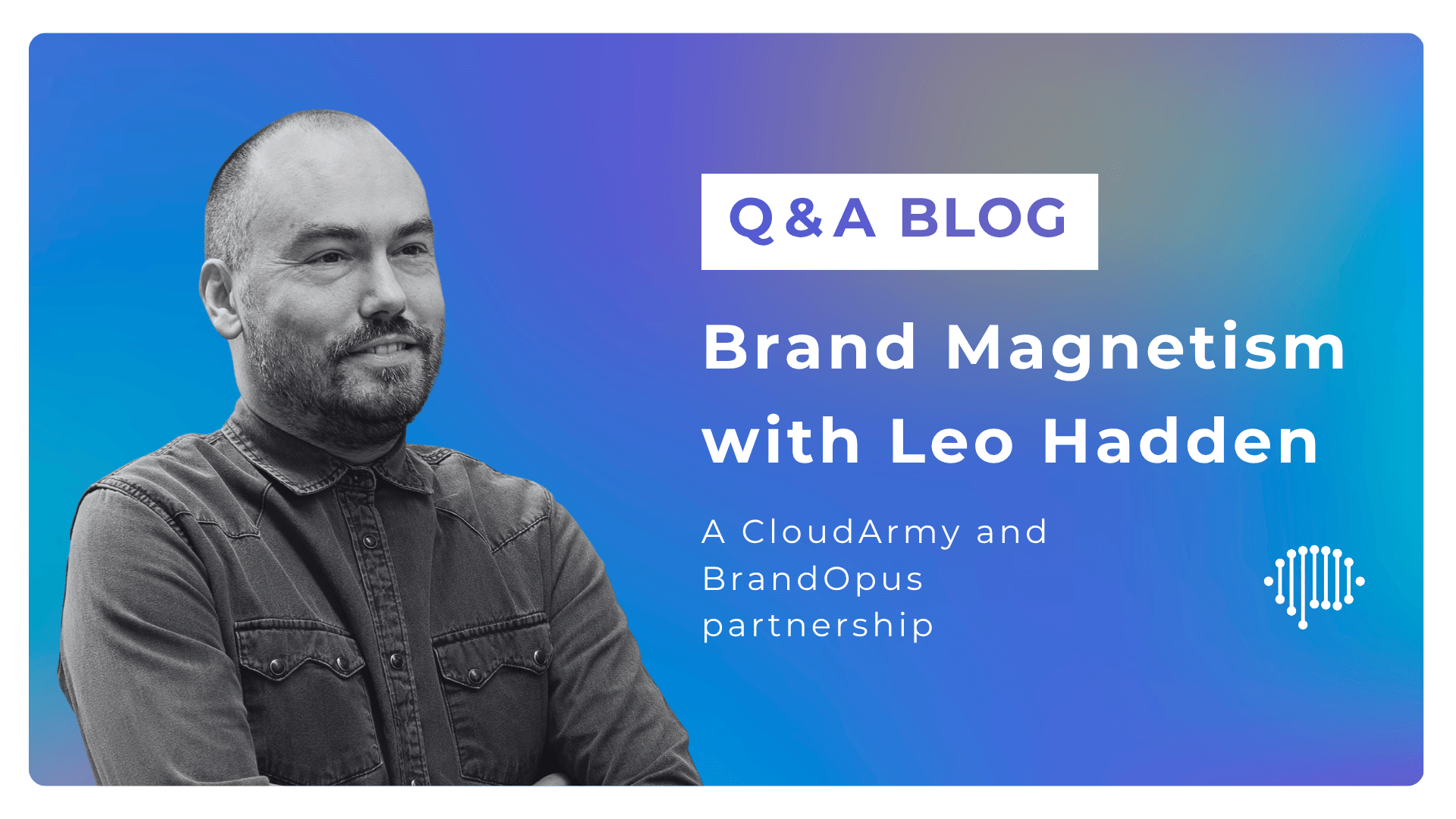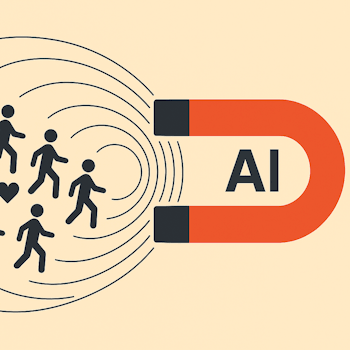
What makes a truly memorable and powerful brand? In this Q&A, we speak with Leo Hadden from BrandOpus about Brand Magnetism, a new science-led approach to testing brand identity developed in partnership with CloudArmy. Built using our Reactor platform, Brand Magnetism helps brands understand the strength of their identity systems by measuring how meaning resonates and assets connect. Leo shares how this methodology is helping marketers cut through the noise, build stronger emotional connections, and drive commercial impact.
Q: What is a brand identity?
It’s a system of visual, verbal, sonic, physical or even experiential assets that work together to create a whole that’s greater than the sum of its parts. The individual assets need to be intentional, unmistakable, and easy to recall – for maximum effect – and collectively they need to hold together in the world and mind.
From a perceptual perspective, which is arguably the most commercially-critical definition, brand identity is a network of interconnected mental associations – borne from every exposure to and interaction with the brand. It can be thought of like a non-cognitive, multidimensional form of reputation.
It’s both strategic and creative - a powerful, always-on tool that frames perceptions, guides behaviour, and builds connection and equity with every interaction. So much more than a simple signpost to a product or service.
Thankfully, the components of brand identity are relatively straight-forward: clarity around what you stand for, and conviction with how you express that to the world!
Q: Why was it important to BrandOpus to have a science-led approach to testing?
We wanted to give marketers robust data about their brand identity. The test provides insights that enable brand owners to make informed decisions about how their brand can be more effective across all their marketing activity.
We believe that creativity and commercial impact go hand in hand, but to unlock that connection, we needed to go beyond intuition. A science-led approach gives us the tools to measure what actually works (and what doesn’t), reducing subjectivity and bias.
We have always anchored our approach in the actual drivers of human behaviour, and we identified that when it comes to testing brand identity (specifically) there was a gap between how people naturally engage in the world, and the ways most research is structured and conducted. Working with CloudArmy allowed us to go beyond traditional methods and tap into implicit paradigms, which reveal underlying reactions that people often can’t articulate consciously. Therefore, improving the quality of insights.
This approach was so important to us because it better reflects the ways people naturally engage with brand identity: without much deliberative thought.
Q: What is Brand Magnetism?
Brands are battling a complex war for attention and cultural relevance with consumers. They need to cut through noise, intuitively draw people in, and hold together across all touchpoints. Magnetism is a metaphor for the degree to which a brand’s meaning attracts, and its assets connect. Those are the two key dimensions of brand identity that we believe maximise marketing effectiveness.
The Magnetism test is a quantifiable consumer-based tool that assesses the effectiveness of any brand’s identity system. It provides a deep, intuitive read that enables brand owners to make more informed decisions.
The test measures two dimensions – the strength of a brand’s resonance i.e. how well the associations of the brand instinctively attract people, and the strength of a brand’s assets system.
It generates a single Magnetism percentage score for every brand, as well as a deep dive into the two modules. Results are benchmarked relative to the performance of other brands in the test, as well as our wider data set that includes the Top 50 most valuable FMCG brands.
Q: Why is Brand Magnetism important?
Brands today exist across fragmented channels and touchpoints, and their audiences experience unprecedented cognitive load – the upshot of this means brands become fragmented in our minds, as they struggle to occupy a definite space. Identities become diluted; messages blurred - leading to a decline in marketing effectiveness.
Brand Magnetism brings us back to the fundamentals of marketing: creating brands that cut through, resonate intuitively, and are easy to recall. By building identity systems rooted in meaning and symbolism we can create coherence across every expression of the brand. That cohesion not only maximises impact but also improves marketing effectiveness.
In short, Brand Magnetism means going beyond simply standing out - to drawing people in and connecting everywhere.
Q: What is the role of memory in brand identity?
Memory is a key part of the foundation of brand identity. The most effective brand identity systems don’t just stand out; they stick in the mind – leveraging meaning and symbolism to enhance memorability. This is more sophisticated than distinctiveness alone.
Brands need to create positive associations in the minds of consumers, in the moment, as well as before and after. Remember, if you want people to buy more than once they’re going to need to remember you!
Q: How can brands become more memorable?
To be memorable, a brand not only needs to be distinctive, but meaningful too. Meaningful brand identities enhance memory by triggering associations that create deeper emotional and neural connections, making brands more persuasive and commercially effective.
Our brains constantly look for short-cuts to transfer information in the most efficient way, reducing cognitive load. Symbols are processed more quickly than words, making them more effective at transmitting meaning. It was no surprise that the most magnetic brands in our report use symbols in their identity systems!
Symbols aren’t mandatory, but they are something of a cheat code when it comes to transferring meaning and enhancing memorability.
Q: Do brands need multiple distinctive assets?
Yes – the modern marketing mix demands it – but consistency and cohesion are also key. So it’s a matter of understanding the equity in your assets, and leveraging them strategically.
It’s unrealistic to think that every asset in your toolkit can become instantly recognisable and emotionally resonant. This is especially true when dealing with assets that relate to generic or category tropes - where a water drop, or wheatsheaf could easily be mistaken for another brand.
We ran the Top 50 most valuable brands in the UK through the Magnetism Test and it the findings suggest that a minimum of three is the magic number. One strong asset applied consistently can certainly build recognition, but it won’t have the breadth that today’s marketing mix demands. Too many assets and you risk diluting that strength, losing clarity and confidence on which assets to use when and where.
Q: How can brands use The Magnetism test?
The Magnetism test yields clear and actionable insights, unlocking opportunities for brand-level optimisations that drive greater effectiveness across marketing activities.
It can diagnose the performance of any brand’s identity system overall, as well as at an individual asset level – including misattribution to other brands. It can also test what the brand stands for in the minds of consumers and measure the strength of selected attributes – to understand the meaning and associations the brand carries, relative to competitors.
This can inform brands on which assets to retain, reimagine or relinquish, and help them learn what they stand for, to see if it is what they had intended, and whether it’s distinct from their competitors.
Q: If I’m not a big brand, like those in the UK top 50, is Brand magnetism relevant to me?
Absolutely. Brand Magnetism isn’t about size - it’s about building a brand that people are instinctively drawn to. Whether you’re a challenger brand, a startup, or a category leader, the principles behind magnetism apply; strength of brand resonance, and strength of assets.
For smaller or emerging brands, it can be a powerful diagnostic to understand where you can most effectively invest in order to amplify impact and build stronger connections with your audience from day one.
Q: Once we’ve established the Magnetism of my brand, what are the next steps? Can my magnetism be improved?
Yes, once the Magnetism test is complete, the strengths and weaknesses of the brand’s identity system is clear. This allows brand owners to make informed decisions on what needs to be optimised.
If a brand has weak brand assets but strong brand resonance, it has the opportunity to optimise its visual identity system to build a stronger image in consumers’ minds.
If a brand has weak brand resonance but strong brand assets, it has the opportunity to optimise what the brand stands for in consumers’ minds to deepen their connection.
If a brand has both weak brand resonance but weak brand assets, it has the opportunity to optimise or rebuild both visual identity and brand meaning.
We analyse the data and pull together a debrief report to clearly show what the brand needs to do to structure their identity to maximises cohesion, mental availability, and long-term effectiveness.
Q: Are some assets more important than others?
Some assets may work harder than others, but what really matters is how they come together as a coherent system. A logo might be the most immediately recognisable element, but on its own it can’t carry the weight of your brand. Typeface, colour palette, tone of voice, tagline - these can all play important roles in creating a strong brand world. It’s about how all the assets interact to drive recognition, emotion, and recall. The most magnetic brands don’t just have one standout asset, they create a unified system that feels unmistakably theirs at every touchpoint.
Q: Any final thoughts on Brand Magnetism?
That it’s more relevant today than ever before – as brand owners and consumers alike are exposed to unprecedented distraction, choice, and fragmentation. We can’t mute the noise, but we can structure brands for success in that context.
To learn more about Brand Magnetism, check out our podcast with Nir Wegrzyn and download an exclusive case study.





